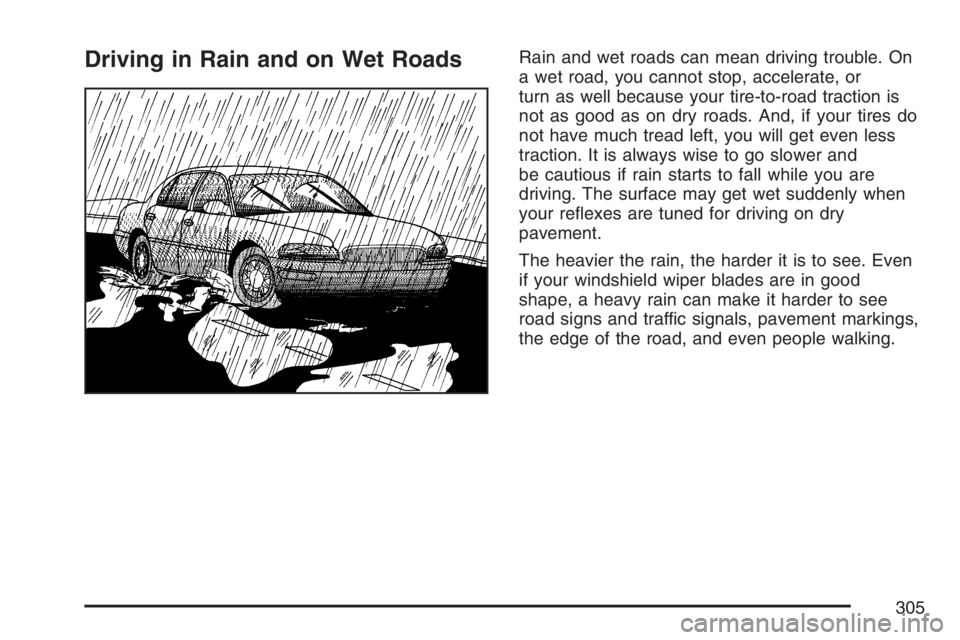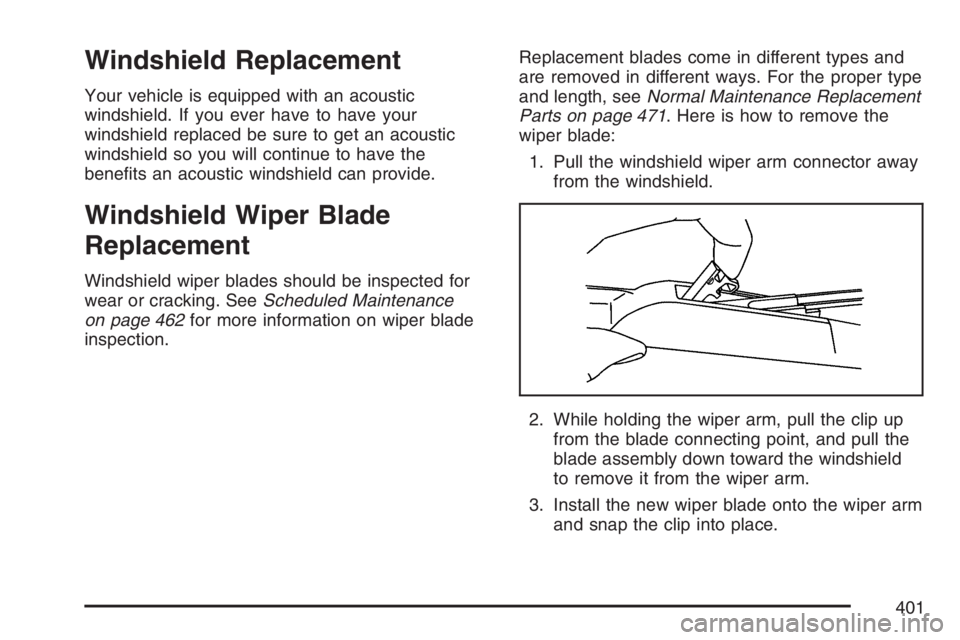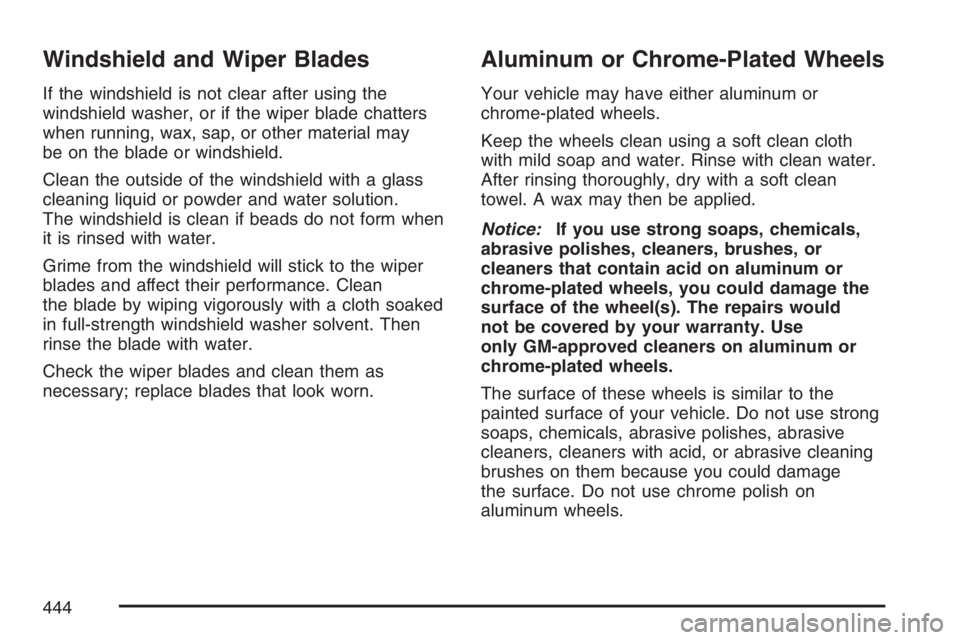2007 BUICK LACROSSE wiper blades
[x] Cancel search: wiper bladesPage 153 of 512

Headlamp High/Low-Beam Changer
To change the headlamps from low beam to
high beam, push the turn signal/multifunction
lever away from you.
When the high beams
are on, a light on the
instrument panel cluster
also will be on if the
ignition is on.
To change the headlamps from high beam to low
beam, pull the turn signal lever toward you.
Flash-to-Pass
This feature lets you use your high-beam
headlamps momentarily to signal a driver in
front of you that you want to pass.
To use it, pull the turn signal/multifunction lever
toward you until the high-beam headlamps
come on, then release the lever to turn them off.
Windshield Wipers
Be sure to clear ice and snow from the wiper
blades before using them. If they are frozen to the
windshield, gently loosen or thaw them. Damaged
wiper blades may not clear the windshield well,
making it harder to see and drive safely. If the
blades do become damaged, install new blades or
blade inserts. For more information, seeWindshield
Wiper Blade Replacement on page 401.
Heavy snow or ice can overload the wiper motor. A
circuit breaker will stop the motor until it cools down.
Clear away snow or ice to prevent an overload.
You control the windshield wipers by turning the
band with the wiper symbol on it.
8(Mist):For a single wiping cycle, turn the
band to mist. Hold it there until the wipers
start. Then let go. The wipers will stop after
one wipe. If you want more wipe cycles, hold
the band on mist longer.
153
Page 305 of 512

Driving in Rain and on Wet RoadsRain and wet roads can mean driving trouble. On
a wet road, you cannot stop, accelerate, or
turn as well because your tire-to-road traction is
not as good as on dry roads. And, if your tires do
not have much tread left, you will get even less
traction. It is always wise to go slower and
be cautious if rain starts to fall while you are
driving. The surface may get wet suddenly when
your re�exes are tuned for driving on dry
pavement.
The heavier the rain, the harder it is to see. Even
if your windshield wiper blades are in good
shape, a heavy rain can make it harder to see
road signs and traffic signals, pavement markings,
the edge of the road, and even people walking.
305
Page 310 of 512

Once you are moving on the freeway, make
certain you allow a reasonable following distance.
Expect to move slightly slower at night.
When you want to leave the freeway, move to the
proper lane well in advance. If you miss your
exit, do not, under any circumstances, stop and
back up. Drive on to the next exit.
The exit ramp can be curved, sometimes quite
sharply. The exit speed is usually posted. Reduce
your speed according to your speedometer, not
to your sense of motion. After driving for any
distance at higher speeds, you may tend to think
you are going slower than you actually are.
Before Leaving on a Long Trip
Make sure you are ready. Try to be well rested. If
you must start when you are not fresh — such
as after a day’s work — do not plan to make too
many miles that �rst part of the journey. Wear
comfortable clothing and shoes you can easily
drive in.Is your vehicle ready for a long trip? If you keep it
serviced and maintained, it is ready to go. If it needs
service, have it done before starting out. Of course,
you will �nd experienced and able service experts
in GM dealerships all across North America. They
will be ready and willing to help if you need it.
Here are some things you can check before a trip:
Windshield Washer Fluid:Is the reservoir
full? Are all windows clean inside and outside?
Wiper Blades:Are they in good shape?
Fuel, Engine Oil, Other Fluids:Have you
checked all levels?
Lamps:Are they all working? Are the lenses
clean?
Tires:They are vitally important to a safe,
trouble-free trip. Is the tread good enough
for long-distance driving? Are the tires
all in�ated to the recommended pressure?
Weather Forecasts:What is the weather
outlook along your route? Should you
delay your trip a short time to avoid a major
storm system?
Maps:Do you have up-to-date maps?
310
Page 338 of 512

Windshield Wiper Blade Replacement....... 401
Tires............................................................ 402
Tire Sidewall Labeling............................... 403
Tire Terminology and De�nitions............... 406
In�ation - Tire Pressure............................. 409
Tire Pressure Monitor System................... 411
Tire Inspection and Rotation...................... 416
When It Is Time for New Tires.................. 417
Buying New Tires...................................... 418
Different Size Tires and Wheels................ 420
Uniform Tire Quality Grading..................... 421
Wheel Alignment and Tire Balance............ 422
Wheel Replacement.................................. 422
Tire Chains............................................... 424
If a Tire Goes Flat.................................... 425
Changing a Flat Tire................................. 426
Removing the Spare Tire and Tools.......... 427
Removing the Flat Tire and Installing
the Spare Tire....................................... 429
Storing a Flat or Spare Tire and Tools...... 435
Compact Spare Tire.................................. 437Appearance Care........................................ 438
Cleaning the Inside of Your Vehicle.......... 438
Fabric/Carpet............................................. 440
Leather...................................................... 441
Instrument Panel, Vinyl, and Other
Plastic Surfaces..................................... 441
Care of Safety Belts.................................. 442
Weatherstrips............................................ 442
Washing Your Vehicle............................... 442
Cleaning Exterior Lamps/Lenses................ 443
Finish Care............................................... 443
Windshield and Wiper Blades.................... 444
Aluminum or Chrome-Plated Wheels......... 444
Tires......................................................... 445
Sheet Metal Damage................................. 445
Finish Damage.......................................... 446
Underbody Maintenance............................ 446
Chemical Paint Spotting............................ 446
Vehicle Care/Appearance Materials............ 447
Section 5 Service and Appearance Care
338
Page 401 of 512

Windshield Replacement
Your vehicle is equipped with an acoustic
windshield. If you ever have to have your
windshield replaced be sure to get an acoustic
windshield so you will continue to have the
bene�ts an acoustic windshield can provide.
Windshield Wiper Blade
Replacement
Windshield wiper blades should be inspected for
wear or cracking. SeeScheduled Maintenance
on page 462for more information on wiper blade
inspection.Replacement blades come in different types and
are removed in different ways. For the proper type
and length, seeNormal Maintenance Replacement
Parts on page 471. Here is how to remove the
wiper blade:
1. Pull the windshield wiper arm connector away
from the windshield.
2. While holding the wiper arm, pull the clip up
from the blade connecting point, and pull the
blade assembly down toward the windshield
to remove it from the wiper arm.
3. Install the new wiper blade onto the wiper arm
and snap the clip into place.
401
Page 444 of 512

Windshield and Wiper Blades
If the windshield is not clear after using the
windshield washer, or if the wiper blade chatters
when running, wax, sap, or other material may
be on the blade or windshield.
Clean the outside of the windshield with a glass
cleaning liquid or powder and water solution.
The windshield is clean if beads do not form when
it is rinsed with water.
Grime from the windshield will stick to the wiper
blades and affect their performance. Clean
the blade by wiping vigorously with a cloth soaked
in full-strength windshield washer solvent. Then
rinse the blade with water.
Check the wiper blades and clean them as
necessary; replace blades that look worn.
Aluminum or Chrome-Plated Wheels
Your vehicle may have either aluminum or
chrome-plated wheels.
Keep the wheels clean using a soft clean cloth
with mild soap and water. Rinse with clean water.
After rinsing thoroughly, dry with a soft clean
towel. A wax may then be applied.
Notice:If you use strong soaps, chemicals,
abrasive polishes, cleaners, brushes, or
cleaners that contain acid on aluminum or
chrome-plated wheels, you could damage the
surface of the wheel(s). The repairs would
not be covered by your warranty. Use
only GM-approved cleaners on aluminum or
chrome-plated wheels.
The surface of these wheels is similar to the
painted surface of your vehicle. Do not use strong
soaps, chemicals, abrasive polishes, abrasive
cleaners, cleaners with acid, or abrasive cleaning
brushes on them because you could damage
the surface. Do not use chrome polish on
aluminum wheels.
444
Page 463 of 512

Scheduled Maintenance
Service MaintenanceIMaintenanceII
Change engine oil and �lter. SeeEngine Oil on page 353. Reset oil life system.
SeeEngine Oil Life System on page 356.An Emission Control Service.••
Visually check for any leaks or damage.See footnote (k).••
Inspect engine air cleaner �lter. If necessary, replace �lter. SeeEngine Air
Cleaner/Filter on page 358.See footnote (l).•
Rotate tires and check in�ation pressures and wear. SeeTire Inspection and
Rotation on page 416and “Tire Wear Inspection” inAt Least Once a Month
on page 467.••
Inspect brake system.See footnote (a).••
Check engine coolant and windshield washer �uid levels and add �uid
as needed.••
Perform any needed additional services. See “Additional Required Services”
in this section.••
Inspect suspension and steering components.See footnote (b).•
Inspect engine cooling system.See footnote (c).•
Inspect wiper blades.See footnote (d).•
Inspect restraint system components.See footnote (e).•
Lubricate body components.See footnote (f).•
Check transaxle �uid level and add �uid as needed.•
Replace passenger compartment air �lter.See footnote (g).•
Inspect throttle system.See footnote (j).•
463
Page 465 of 512

Maintenance Footnotes
(a)Visually inspect brake lines and hoses for
proper hook-up, binding, leaks, cracks, cha�ng,
etc. Inspect disc brake pads for wear and rotors for
surface condition. Inspect other brake parts,
including calipers, parking brake, etc.
(b)Visually inspect front and rear suspension and
steering system for damaged, loose, or missing
parts or signs of wear. Inspect power steering lines
and hoses for proper hook-up, binding, leaks,
cracks, cha�ng, etc.
(c)Visually inspect hoses and have them replaced
if they are cracked, swollen, or deteriorated.
Inspect all pipes, �ttings and clamps; replace with
genuine GM parts as needed. To help ensure
proper operation, a pressure test of the cooling
system and pressure cap and cleaning the outside
of the radiator and air conditioning condenser is
recommended at least once a year.
(d)Visually inspect wiper blades for wear or
cracking. Replace wiper blades that appear worn
or damaged or that streak or miss areas of
the windshield.(e)Make sure the safety belt reminder light and all
your belts, buckles, latch plates, retractors, and
anchorages are working properly. Look for
any other loose or damaged safety belt system
parts. If you see anything that might keep a safety
belt system from doing its job, have it repaired.
Have any torn or frayed safety belts replaced. Also
look for any opened or broken airbag coverings,
and have them repaired or replaced. The
airbag system does not need regular maintenance.
(f)Lubricate all key lock cylinders. Lubricate all
hinges and latches, including those for the
body doors, hood, secondary latch, pivots, spring
anchor, release pawl, rear compartment, glove
box door, and console door. More frequent
lubrication may be required when exposed to a
corrosive environment. Applying silicone grease on
weatherstrips with a clean cloth will make them
last longer, seal better, and not stick or squeak.
(g)If you drive regularly under dusty conditions,
the �lter may require replacement more often.
465